LeBaron Incorporated
Coordinates: 42°23′03″N 82°58′44″W / 42.3840732°N 82.9788219°W LeBaron Incorporated (originally LeBaron, Carrossiers Inc.) was a design and coach building company from 1920 until 1953. American designers Raymond H. Dietrich and Thomas L. Hibbard had met while working for Brewster. LeBaron was founded in New York City in 1920 by Raymond H. Dietrich and Thomas L. Hibbard.[1] The company originally was called LeBaron, Carrossiers Inc., and served as design consultants. Dietrich and Hibbard were unknown outside of Brewster, so a clever new name - LeBaron, Carrossiers - was arrived at by the two partners using a list of French words that had the ring of prestige and could be easily pronounced through a telephone.[1]
Founding
Business progressed in 1920 that Thomas Hibbard offered his friend, Ralph Roberts, who had just gotten his Bachelor of Science degree from Dartmouth College, a job. Tom Hibbard met fellow designer, Howard A. "Dutch" Darrin in 1923. Hibbard and Darrin decided to go to Paris, initially to try to sell LeBaron designs but instead decided to set up their own company and founded Hibbard & Darrin. Hibbard resigned from LeBaron in 1923. Dietrich and Roberts continued operating LeBaron with a new illustrator, veteran Roland L. Stickney.[1]Tiring of the corporate environment they started freelance work in their spare time and when William H. Brewster discovered this he fired Dietrich and Hibbard left.[2][1]
In 1924, LeBaron merged with the Blue Ribbon and Bridgeport Body companies and changed their name to LeBaron Inc., becoming body builders as well as designers.[3][4][1][5] LeBaron became one of the many prominent coachbuilders in the 1920s to provide bodies for luxury cars. Until the late 1930s, most of the great prestige automakers - Rolls-Royce, Hispano-Suiza, Duesenberg, Packard - often supplied only a running chassis, which wealthy buyers would outfit with custom bodywork at substantial extra cost.
Briggs Manufacturing
Dietrich received a lucrative offer from Murray Corporation, one of Ford's and Lincoln's main body builders, in 1925 and resigned from LeBaron to start Dietrich, Inc.. With both founders gone, LeBaron could have been in trouble. But Roberts continued to run the company and orders kept coming in. Walter O. Briggs began talks with Roberts in 1926 to buy LeBaron and move it to Detroit, setting up operations at Mack Avenue Stamping (Old Mack Factory).[6]
LeBaron was purchased by Briggs Manufacturing Company of Detroit in 1926 and operated as a subsidiary. Briggs was already supplying bodies to nearby Chrysler, Essex, Ford, Hudson, and Overland. As a Briggs subsidiary, LeBaron handled special custom work, provided design ideas for the main business, and supplied exquisite custom bodies for various car companies such as Chrysler's luxury Imperial line, Duesenberg, Packard, and Cadillac. In 1932, for example, they built 28 beautiful Imperial Custom Convertible Coupes, Chrysler's top model, which rode a 146-inch wheelbase and used a 384.8 cubic-inch straight-8 engine.[3][1][5]
Thomas L. Hibbard became design director at Ford in 1947. Raymond H. Dietrich was hired by Chrysler in 1932 to become the first official Chrysler stylist.[1][5]
Gallery
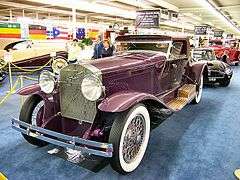 Isotta Fraschini 1928
Isotta Fraschini 1928 Duesenberg 1929
Duesenberg 1929 Pierce-Arrow 1931
Pierce-Arrow 1931 Marmon 1932
Marmon 1932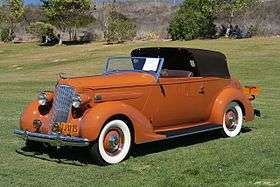 Packard 1936
Packard 1936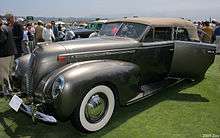 Lincoln 1938
Lincoln 1938 Packard 1941
Packard 1941 Packard 1941
Packard 1941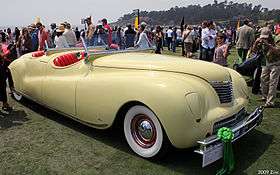 Chrysler Newport 1941
Chrysler Newport 1941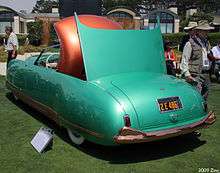 Chrysler Thunderbolt 1941
Chrysler Thunderbolt 1941
References
- 1 2 3 4 5 6 7 "LeBaron". coachbuilt.com. Retrieved July 28, 2017.
- ↑ "Howard A. Darrin". Hemmings Classic Car. Retrieved July 28, 2017.
- 1 2 "Chrysler LeBaron History". webring.com. Archived from the original on 2010-12-06.
- ↑ "1985 Chrysler LeBaron (LeBaron Town & Country, LeBaron Mark Cross Convertible, T&C, LeBaron GTS, LS Sedan) - Conceptcarz.com". conceptcarz.com.
- 1 2 3 "Briggs Mfg. Co., Briggs Bodied, Briggs Body Company, Walter O. Briggs, LeBaron, Briggs Detroit, John Tjaarda, Coachbult.com -". coachbuilt.com.
- ↑ History of Mack Avenue factories
External links
| Wikimedia Commons has media related to LeBaron Coachwork. |